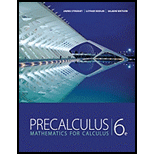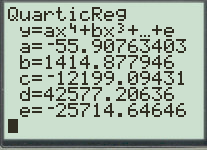
Concept explainers
(a)
To find: The quartic polynomial that best fits the given data.
(a)
Answer to Problem 4P
The quartic polynomial that best fits the given data is equal to
Explanation of Solution
Given information:
Clothing sales tend to vary by season, with more clothes sold in spring and fall. The table gives sales figures for each month at a certain clothing center.
| Month | Sales |
| January | |
| February | |
| March | |
| April | |
| May | |
| June | |
| July | |
| August | |
| September | |
| October | |
| November | |
| December |
Calculation:
Take the sales per thousand i.e.
For the quartic model of data follow the steps below:
First press the
Go to
Now enter the keystrokes

Figure(1)
Therefore, the quartic polynomial that best fits the given data is equal to
(b)
To graph: The scatter plot of the given data and the quadratic polynomial obtained from part(a) in the same viewing window.
(b)
Explanation of Solution
Given information:
Clothing sales tend to vary by season, with more clothes sold in spring and fall. The table gives sales figures for each month at a certain clothing center.
| Month | Sales |
| January | |
| February | |
| March | |
| April | |
| May | |
| June | |
| July | |
| August | |
| September | |
| October | |
| November | |
| December |
Graph:
To graph the points on scatter plot, follow the steps using graphing calculator.
First press the
Go to
Now press the key
Now, press the

Figure (2)
(c)
To check: Whether the quartic polynomial is a good model for these data.
(c)
Answer to Problem 4P
Yes, the quartic model is good for these set of data as all the points are scattered in the graph of scatter plot and all the points lie near the line of model.
Explanation of Solution
Given information:
Clothing sales tend to vary by season, with more clothes sold in spring and fall. The table gives sales figures for each month at a certain clothing center.
| Month | Sales |
| January | |
| February | |
| March | |
| April | |
| May | |
| June | |
| July | |
| August | |
| September | |
| October | |
| November | |
| December |
Calculation:
As observed from the graph in part(b), the points on the graph of scatter plot are scattered and all the points lies near the graph of the model.
Therefore, the quartic model is good for these set of data as all the points are scattered in the graph of scatter plot and all the points lie near the line of model.
Chapter 3 Solutions
Precalculus: Mathematics for Calculus - 6th Edition
 Calculus: Early TranscendentalsCalculusISBN:9781285741550Author:James StewartPublisher:Cengage Learning
Calculus: Early TranscendentalsCalculusISBN:9781285741550Author:James StewartPublisher:Cengage Learning Thomas' Calculus (14th Edition)CalculusISBN:9780134438986Author:Joel R. Hass, Christopher E. Heil, Maurice D. WeirPublisher:PEARSON
Thomas' Calculus (14th Edition)CalculusISBN:9780134438986Author:Joel R. Hass, Christopher E. Heil, Maurice D. WeirPublisher:PEARSON Calculus: Early Transcendentals (3rd Edition)CalculusISBN:9780134763644Author:William L. Briggs, Lyle Cochran, Bernard Gillett, Eric SchulzPublisher:PEARSON
Calculus: Early Transcendentals (3rd Edition)CalculusISBN:9780134763644Author:William L. Briggs, Lyle Cochran, Bernard Gillett, Eric SchulzPublisher:PEARSON Calculus: Early TranscendentalsCalculusISBN:9781319050740Author:Jon Rogawski, Colin Adams, Robert FranzosaPublisher:W. H. Freeman
Calculus: Early TranscendentalsCalculusISBN:9781319050740Author:Jon Rogawski, Colin Adams, Robert FranzosaPublisher:W. H. Freeman
 Calculus: Early Transcendental FunctionsCalculusISBN:9781337552516Author:Ron Larson, Bruce H. EdwardsPublisher:Cengage Learning
Calculus: Early Transcendental FunctionsCalculusISBN:9781337552516Author:Ron Larson, Bruce H. EdwardsPublisher:Cengage Learning





